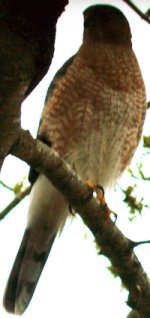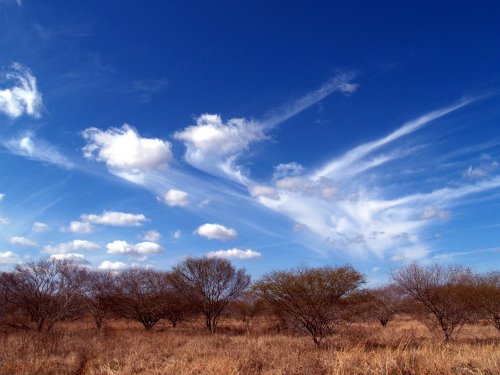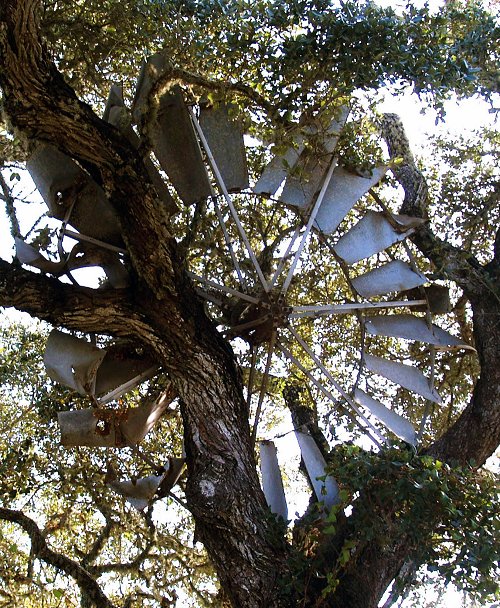Birds in the Brush
Today, let's go birding. The University of Houston's College of Engineering presents this series about the machines that make our civilization run, and the people whose ingenuity created them.
It was a quiet week in South Texas -- nothing much happened beyond the Vice President's unfortunate hunting accident. We too were hunting, not far from the Armstrong Ranch, and it went without incident. I had my 150-gauge digital camera with its conical spread of 7-1/2 degrees. I bagged any number of lovely birds.
The inland coastal landscape is dead flat and immense. Migratory birds wheel across the vast sky. Look out across the plowed fields that extend to infinity, and you see a horizon formed by a watery mirage shimmering over the dry dirt.

The Aransas Wildlife refuge is a large coastal marsh where whooping cranes spend their winters. These five-foot tall birds go by twos -- an adult male and female, joined for life. With luck, they'll have one offspring with them. Fewer than four-hundred of these birds exist, and most spend their winters here.

There're lots of egrets, cormorants, and rosy spoonbills. They and whooping cranes are best seen from a shallow-draft boat carefully nosing through the sometimes-five-foot-deep waters of the Aransas and Carlos Bays. Gulls are everywhere. They like boats. A barge loaded with 12-inch diameter steel pipe ploughs the Intercoastal Waterway. The pipes form an aircraft-carrier deck, and it's carpeted with gulls. The barge propellers churn up a steady diet of chopped fish and other nutrients for them.

 Like gulls, elegant black and white pelicans haunt shores as well as marshes. They line the piers studying our boat as it comes and goes. Oysters are a major crop here. Oyster boats are everywhere. So are oyster shells. Early settlers mixed their hard nacre in with cement to make formidable concrete. You see it in ruins of James Powers' early nineteenth-century settlement on Copano Bay. You see it in the extravagant mansion built by wealthy ranchers Harriet and George Fulton, forty years later. Houses had to be sturdy. Behind the mansion we find a complete ten-foot-diameter, century-old windmill fan, lodged in a tree by an old hurricane.
Like gulls, elegant black and white pelicans haunt shores as well as marshes. They line the piers studying our boat as it comes and goes. Oysters are a major crop here. Oyster boats are everywhere. So are oyster shells. Early settlers mixed their hard nacre in with cement to make formidable concrete. You see it in ruins of James Powers' early nineteenth-century settlement on Copano Bay. You see it in the extravagant mansion built by wealthy ranchers Harriet and George Fulton, forty years later. Houses had to be sturdy. Behind the mansion we find a complete ten-foot-diameter, century-old windmill fan, lodged in a tree by an old hurricane.
 The inland bird population is different. One inland birder told us that there're only two kinds of flying creature: raptors and birdfeed. Most of the raptors are hawks. They wheel in the sky, looking. Or they perch on telephone poles, waiting.
The inland bird population is different. One inland birder told us that there're only two kinds of flying creature: raptors and birdfeed. Most of the raptors are hawks. They wheel in the sky, looking. Or they perch on telephone poles, waiting.
There's plenty of birdfeed: songbirds, pipers and plovers, green jays, cardinals -- birds that we city-folk don't see without assistance because we've taken them for granted too long.
 After three days in these immensities we're back in Houston taking much less for granted. Then, in today's dark early morning, we look out the back window and see a creature on a tree limb -- one we've never seen here before. I sieze my camera and begin shooting wildly. I hit all sorts of things, a tree branch, a window frame. Finally I bag him. He's a large Coopers Hawk quietly sizing us up. He correctly concludes, at last, that we're not birdfeed, but more dangerous raptors still. And he flies away.
After three days in these immensities we're back in Houston taking much less for granted. Then, in today's dark early morning, we look out the back window and see a creature on a tree limb -- one we've never seen here before. I sieze my camera and begin shooting wildly. I hit all sorts of things, a tree branch, a window frame. Finally I bag him. He's a large Coopers Hawk quietly sizing us up. He correctly concludes, at last, that we're not birdfeed, but more dangerous raptors still. And he flies away.
I'm John Lienhard, at the University of Houston, where we're interested in the way inventive minds work.
This birding adventure was an Elderhostel trip on Feb. 13-16, 2006, centered on Fulton, TX. The boat tours were conducted by Rockport Birding and Kayak Adventures, Fulton, TX.


